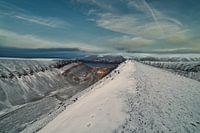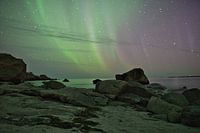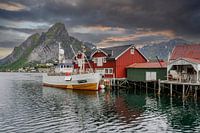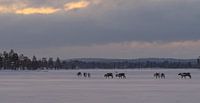Buy the photo Giant Petrel by Kai Müller on canvas, ArtFrame, poster and wallpaper, printed on demand in high quality.
About "Giant Petrel"
by Kai Müller
About the artwork
The Giant Petrel (Macronectes giganteus), also called Southern Giant Petrel, is a breeding bird of the Antarctic mainland as well as many sub-Antarctic islands. Outside the breeding season, in which the bird, which belongs to the petrel family, breeds in colonies in contrast to the Hall's petrel, they spend most of their lives on the high seas and can then be observed as far as the Tropic of Capricorn. Like Hall's petrels, giant petrels are called "stinkers" by seafarers because they vomit an oily and smelly stomach content when frightened. This enables them to rise faster into the air.
The giant petrel reaches a wingspan of up to 200 cm and a body length of 84 to 92 cm. Its plumage is a dusky grey-brown, which is strikingly lighter on the head, neck and throat. Giant petrels are easily recognisable by their huge, horn-plate beak with its elongated nose-double tube (tube noses). The small light eyes are surrounded by a feather wheel, the colour of the feet ranges from brown to smoky black.
Compared to the albatross, their flight appears more clumsy, as they flap less elegantly or glide along in a stiff-winged posture with their head held low. Giant petrels are scavengers, feeding on dead marine animals floating on the sea surface, but also on young penguins. They often follow ships in search of scraps.

About Kai Müller
For as long as I can remember I have always been drawn to the beauty of the environment and the wild spirit of wildlife. However, my love for nature and wildlife photography began a few years back after a series of travels coupled with my studies in design. .. Read more…
 Germany
Germany Ordered in April 2021
Ordered in April 2021
 Germany
Germany Ordered in February 2024
Ordered in February 2024
 Netherlands
Netherlands Ordered in March 2021
Ordered in March 2021
 Netherlands
Netherlands Ordered in August 2024
Ordered in August 2024
 Netherlands
Netherlands Ordered in March 2024
Ordered in March 2024
 Germany
Germany Ordered in September 2025
Ordered in September 2025
 Netherlands
Netherlands Ordered in December 2021
Ordered in December 2021
 Germany
Germany Ordered in January 2020
Ordered in January 2020
 Netherlands
Netherlands Ordered in July 2021
Ordered in July 2021
 Netherlands
Netherlands Ordered in January 2019
Ordered in January 2019
 Germany
Germany Ordered in November 2022
Ordered in November 2022
 Netherlands
Netherlands Ordered in May 2021
Ordered in May 2021
About the material
ArtFrame™
Interchangeable Art Prints
- High-quality print
- Easily interchangeable
- Acoustic function
- Large sizes available
Discover the artworks of Kai Müller
 Reindeer herd in Pasvik National ParkKai Müller
Reindeer herd in Pasvik National ParkKai Müller Northern Lights Panorama LofotenKai Müller
Northern Lights Panorama LofotenKai Müller Polar FoxKai Müller
Polar FoxKai Müller Longyearbyen photographed from the mountain SarkofagenKai Müller
Longyearbyen photographed from the mountain SarkofagenKai Müller Hiorthamn SvalbardKai Müller
Hiorthamn SvalbardKai Müller Pack ice in the AsgardbuktaKai Müller
Pack ice in the AsgardbuktaKai Müller Reindeer herd in Pasvik National ParkKai Müller
Reindeer herd in Pasvik National ParkKai Müller Uttakleiv on the Lofoten under the northern lightsKai Müller
Uttakleiv on the Lofoten under the northern lightsKai Müller Aurora Borealis before the mountainsKai Müller
Aurora Borealis before the mountainsKai Müller WhalersKai Müller
WhalersKai Müller Reine LofotenKai Müller
Reine LofotenKai Müller Reindeer in Pasvik National ParkKai Müller
Reindeer in Pasvik National ParkKai Müller Pasvik National ParkKai Müller
Pasvik National ParkKai Müller Vardø ArtKai Müller
Vardø ArtKai Müller Northern lights over the lighthouse of SlettnesKai Müller
Northern lights over the lighthouse of SlettnesKai Müller Sommarøy in the winter evening lightKai Müller
Sommarøy in the winter evening lightKai Müller Giant Iceberg Antarctic PeninsulaKai Müller
Giant Iceberg Antarctic PeninsulaKai Müller Drift ice in the AntarcticKai Müller
Drift ice in the AntarcticKai Müller HallingskeidKai Müller
HallingskeidKai Müller Lofoten ReineKai Müller
Lofoten ReineKai Müller













 Photo wallpaper
Photo wallpaper Photography
Photography Serene Peace
Serene Peace Wildlife photography
Wildlife photography









